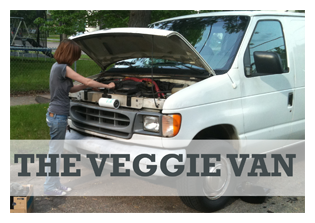
Home |
Shows |
Listen |
Buy |
iTunes |
THE VEGGIE VAN
Jan 29, 2010 by Joseph
On May 9, 2010, we bought a 2000 Ford E350 diesel van that had been converted to run on vegetable oil by a guy named Oren from Ecological Creations in Atlanta, Georgia. We bought it from a musician named Conner whose band had just gotten a video on CMT and moved on to better things. The van had certainly been around, and was in need of a few beautifications, but we were more than ready to move on from the Saturn station wagon we had toured in the summer before. Plus, since the van could run on free waste vegetable oil, we calculated that we'd it pay off in fuel savings with only a few months of touring.
 To be fair, it wasn't Kay who pushed for exploring the idea of buying a vegetable oil powered vehicle. I had first found out about the whole concept on one of my wikipedia binges, probably during a late-night hunger, black tea, or adderall induced curiosity frenzy (it's a wonder anyone gets anything done with wikipedia around; I start the day checking the forecast and four hours later I'm knee deep in seronegative spondyloarthropathy). But somewhere along the line I hit on a site detailing how to convert a diesel engine to run on waste vegetable oil. Holy bajonkers. Waste vegetable oil is free. Gas is $3 a gallon. Is this real?
To be fair, it wasn't Kay who pushed for exploring the idea of buying a vegetable oil powered vehicle. I had first found out about the whole concept on one of my wikipedia binges, probably during a late-night hunger, black tea, or adderall induced curiosity frenzy (it's a wonder anyone gets anything done with wikipedia around; I start the day checking the forecast and four hours later I'm knee deep in seronegative spondyloarthropathy). But somewhere along the line I hit on a site detailing how to convert a diesel engine to run on waste vegetable oil. Holy bajonkers. Waste vegetable oil is free. Gas is $3 a gallon. Is this real?
Now, I knew better than to trust some wacko website, so I used one of the few skills I retained as a philosophy major in college: research.
I took almost a year to be convinced, but I'm now a believer: any diesel engine (though some are better, some worse) can be modified to run on waste vegetable oll, provided the oil is not too acidic, is filtered to 5 microns, is dewatered, and is heated to at least 160 degrees F prior to hitting the injectors.
So we did it. We took the plunge.
Here's how it works: Our van has two tanks. One is the original diesel tank and the other is a custom tank for veggie oil. We can switch between the two whenever we need via two toggle switches on the dash. The reason for two tanks is so that we can start the van on diesel and make sure the engine warms up before introducing the veggie oil. Veggie oil below 160 F is too viscous and won't burn properly. It can clog the injectors and gum up the guts of the engine. The veggie tank is heated via engine coolant lines (engine collant reaches anywhere from 160 to 200 degrees F in a normally operating engine) that run from the engine to the veggie tank. Once the engine is warmed up, we switch over to veggie and ride for free.
However, we can't just pour waste veggie oil right into the tank. We have to make sure it's clean first. We collect the oil from various restaurants on the road (chinese and vegetarian restaurants have the best quality oil while fast food and hamburger places have dirty, fatty oil) and since each restaurant's oil will have varying levels of acidity, dissolved water and particulates, we have to be careful to filter the oil correctly.
Here's one of the filters we use:

Since we bought it, our van has needed several expensive fixes, but we're still on track to break even after only a year of use. Plus, burning veggie oil is carbon neutral, totally non toxic and smells like a delicious meal the whole trip.
To see more of the van go to our veggie van gallery.
To learn more about veggie oil as fuel, visit Journey to Forever.
Jan 29, 2010 by Joseph
On May 9, 2010, we bought a 2000 Ford E350 diesel van that had been converted to run on vegetable oil by a guy named Oren from Ecological Creations in Atlanta, Georgia. We bought it from a musician named Conner whose band had just gotten a video on CMT and moved on to better things. The van had certainly been around, and was in need of a few beautifications, but we were more than ready to move on from the Saturn station wagon we had toured in the summer before. Plus, since the van could run on free waste vegetable oil, we calculated that we'd it pay off in fuel savings with only a few months of touring.
 To be fair, it wasn't Kay who pushed for exploring the idea of buying a vegetable oil powered vehicle. I had first found out about the whole concept on one of my wikipedia binges, probably during a late-night hunger, black tea, or adderall induced curiosity frenzy (it's a wonder anyone gets anything done with wikipedia around; I start the day checking the forecast and four hours later I'm knee deep in seronegative spondyloarthropathy). But somewhere along the line I hit on a site detailing how to convert a diesel engine to run on waste vegetable oil. Holy bajonkers. Waste vegetable oil is free. Gas is $3 a gallon. Is this real?
To be fair, it wasn't Kay who pushed for exploring the idea of buying a vegetable oil powered vehicle. I had first found out about the whole concept on one of my wikipedia binges, probably during a late-night hunger, black tea, or adderall induced curiosity frenzy (it's a wonder anyone gets anything done with wikipedia around; I start the day checking the forecast and four hours later I'm knee deep in seronegative spondyloarthropathy). But somewhere along the line I hit on a site detailing how to convert a diesel engine to run on waste vegetable oil. Holy bajonkers. Waste vegetable oil is free. Gas is $3 a gallon. Is this real? Now, I knew better than to trust some wacko website, so I used one of the few skills I retained as a philosophy major in college: research.
I took almost a year to be convinced, but I'm now a believer: any diesel engine (though some are better, some worse) can be modified to run on waste vegetable oll, provided the oil is not too acidic, is filtered to 5 microns, is dewatered, and is heated to at least 160 degrees F prior to hitting the injectors.
So we did it. We took the plunge.
Here's how it works: Our van has two tanks. One is the original diesel tank and the other is a custom tank for veggie oil. We can switch between the two whenever we need via two toggle switches on the dash. The reason for two tanks is so that we can start the van on diesel and make sure the engine warms up before introducing the veggie oil. Veggie oil below 160 F is too viscous and won't burn properly. It can clog the injectors and gum up the guts of the engine. The veggie tank is heated via engine coolant lines (engine collant reaches anywhere from 160 to 200 degrees F in a normally operating engine) that run from the engine to the veggie tank. Once the engine is warmed up, we switch over to veggie and ride for free.
However, we can't just pour waste veggie oil right into the tank. We have to make sure it's clean first. We collect the oil from various restaurants on the road (chinese and vegetarian restaurants have the best quality oil while fast food and hamburger places have dirty, fatty oil) and since each restaurant's oil will have varying levels of acidity, dissolved water and particulates, we have to be careful to filter the oil correctly.
Here's one of the filters we use:

Since we bought it, our van has needed several expensive fixes, but we're still on track to break even after only a year of use. Plus, burning veggie oil is carbon neutral, totally non toxic and smells like a delicious meal the whole trip.
To see more of the van go to our veggie van gallery.
To learn more about veggie oil as fuel, visit Journey to Forever.
Free Download!









